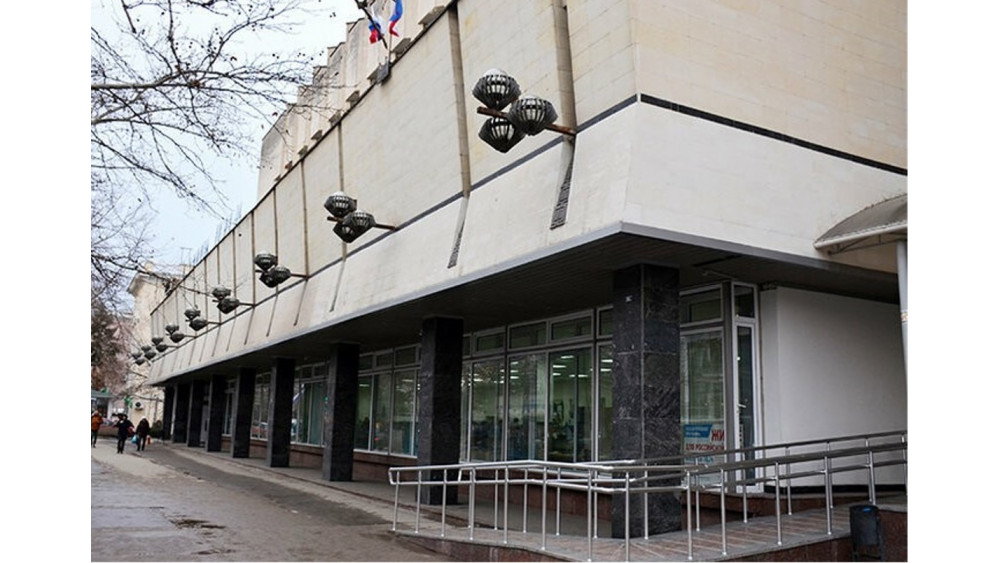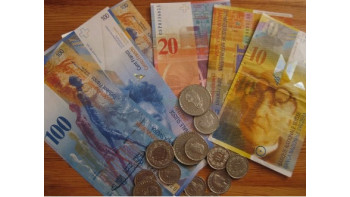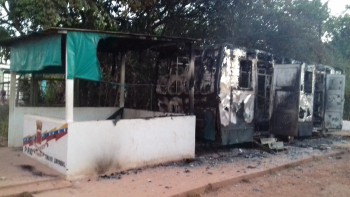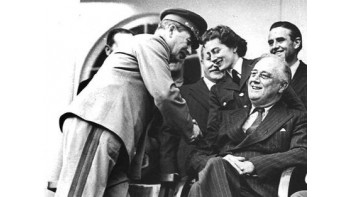The Russian aggression, launched in 2014, led to the formation of invaders’ “administrations” on the territory of Ukraine, which have the characteristics of “quasi-state” entities, the so-called “republics” – “Donetsk People’s Republic” (“DPR”), “Luhansk People’s Republic” (“LPR”), as well as the “Republic of Crimea”, which Russia declared as allegedly its “own territory”. At the same time, the invaders’ “administrations” of Russia, “DPR” and “LPR”, defined by Ukraine as terrorist organizations, are called by Russia as “self-proclaimed republics” and are formed on the model of other similar “republics”, such as Transnistria or Abkhazia. At the same time, as in other “republics”, Russia has formed its own postal services in the “DPR” and “LPR”.
In particular, Russia created in the occupied territories of the Donetsk Region in 2014, the so-called “state enterprise” “Donbas Post”, which began to play the role of “post office” for the invaders’ “administration”. Initially, it was stated that the “Donbas Post” provides “forwarding of items” on the “DPR” and “LPR”. At the same time, similar functions began to be performed by the “state unitary enterprise” “LPR Post”.in the occupied territory of Luhansk Region,
It is noteworthy that as claimed by the means of propaganda of the Russia’s “administration”, “Donbass Post” as a “DNR” “postal operator” “delivered and sent” more than five million items (“letters, wrappers, parcels”) as in the occupied Eastern Ukraine, as well as to and from Russia. In addition, this “postal operator” provides “payment for utilities, communications and the Internet”, as well as “money transfer”. It is stated that in March 2017, the “Donbas Post” “began cooperation” with the “LPR Post”, after which it made 171 thousand “postal transfers” in Russian rubles, a third of which were money transfers to the occupied Luhansk Region.
The invaders’ “administration” seeks to create a beautiful picture for the population that “the post office is operating normally”, but of course these “postal items” of the “postal operator” are possible only within the territories occupied by Russia and in Russia itself. It is noteworthy that the exchange of “postal items” between the “Donbas Post” and the “Russian Post” is carried out in an “indirect way”. Initially, all “postal items” from the occupied Donetsk Region are sent allegedly to the fictitious address of the “Russian Post” in Russia’s Rostov Region, and then it is sent by the tools of the “Russian Post” to the desired addressee. When sending such a letter to the Russian Federation a “post stamp” is not pasted and the person pays as a “registered letter”.
It is noteworthy that the tariffs for “postal items” from the occupied Donbas to Russia (“letters, wrappers, parcels”) are absolutely identical in cost for sending items to Russia by “Russian Post”. The only interesting difference is that “postal items” of “Donbas Post” are moved by “Russian Post” exclusively by land transport and therefore in a significant number of settlements in Russia, where such transport is not available completely or seasonally, such “letter” cannot be sent there from the occupied Donbas.
This fictitious address is the only one for the “Donbas Post” and is called as “subscriber box 12, Kuybyshevo village, Rostov Region, 346940”, and it should be “necessarily indicated” as the alleged “sender’s address” (if the “letter” goes to Russia) or as recipient’s address (if “letter” comes from Russia). In this case, the parentheses must indicate the real arsess after this (with last name, first name, patronymic, index, city, street, house, apartment and phone number of the so-called “mobile operator” “Phoenix”). It is noteworthy that the “Donbas Post” itself urges not to write the name of the country of residence of its own “addressees” in such “address”. At the same time, such a “postal system” causes massive losses of “correspondence” due to the confusion through which even Russian managers “suffer” – both in the Rostov Region and in the invaders’ “administrations” in Ukraine.
“Donbas Post” not only introduced its own “postage stamps” and envelopes, but also it approved a decision in February 2016 to abandon the usage of Ukrainian postal codes, switching to six-digit models similar to those used in the Soviet Union and inherited in Russia. It is noteworthy that such “innovations” of the “postal operator” were not radical and consisted in the fact that the number “2” was simply added to the beginning of the real Ukrainian indexes. At the same time, in Russia itself, postal codes generally remained the same as in the USSR, and at the same time the “Soviet” indexes of Donetsk and Luhansk regions were completely different from those used by “Ukrposhta”.
It is noteworthy that, like other Russian-controlled “republics”, “Donbas Post” periodically issues “postage stamps” to “pay for postal services” as well as for information and propaganda purposes, and to emphasize its own fake “statehood”; those “stamps” have a variety of nominal value, and they are “ordinary and collectible”. The first such “postage stamps” were issued on May 9, 2015, dedicated to the “70th anniversary of the Victory in the Great Patriotic War”, but with the tragicomic name “Givi and Motorola – the heroes of Novorossia”, with face value “V”, ie – 14 Russian rubles. Prior to the publication of this “postage stamp”, authored by the designer L.Kiparisov from St. Petersburg, a “special extinguishing” was even carried out at the Donetsk Main Post Office with the participation of the now dead “heroes” of these “stamps”. In general, the propaganda of war and terrorism became the key goal of such “philatelic measures” in the occupied Donbas.
Therefore, it is not surprising that according to the invaders’ propaganda, among the “more than 200 types of postage stamps” issued by the “Donbas Post”, the “postage stamp” dedicated to Joseph Stalin and issued in December 2019, become the “most popular” with a “circulation of 16 thousands copies, which were sold out in one day”. It should be noted that the already mentioned “LPR Post” was created by Russia in parallel with the “Donbas Post” and the “process of their development” was almost identical. Since 2015, the “LPR Post” also puts “postage stamps” of various face value into circulation regularly, primarily with propaganda purposes. At the same time, the “LPR Post” exchanges by the “postal correspondence” with Russia through the “same post office” in the village of Kuybyshevo, Rostov Region, but through the “subscriber box 21”. Also, unlike the “Donbas Post”, the “LPR Post” did not “transform” the postal codes of “Ukrposhta”.
It should be noted that “Donbas Post” and “LPR Post” also carries out through these “subscriber boxes” in the border Kuybyshevo “delivery of goods from online stores of the Russian Federation and far abroad”. They noted that these “postal operators” are “responsible” only for the delivery of orders to the occupied Donbas from the “Kuybyshevo Post Office”, located near the Ukrainian border and near “Marynivka” checkpoint, seized by the aggressor and officially closed by Ukraine.
It is noteworthy that the philatelic propaganda of the Russian invaders in Eastern Ukraine also covers Crimean issues, which becomes the basis for comprehensive informational special operations. For example, in August 2021, the “LPR Post” issued a thousand copies of the “postal block” entitled “250 years of liberation of the Russian Tavrida from Turkish invaders” of three “stamps” of 42 rubles each, which depicted Christopher Minich, Vasily Dovgoruky-Crimean and a monument to Catherine II in Simferopol. The solemn “first day’s redemption” of these “postage stamps” on August 10, 2021 was broadcasted even on local TV channels, with “patriotic speeches” of “officials” such as Yuri Pershikov, the local “Deputy Minister of Communications and Mass Media”.
We will add that the Sevastopol journalist Pershikov from 2008 to 2014 was actively promoted at the expense of the Russian politicians and special services of the information agenda of “Novorossiya” in the Crimea, but with the beginning of Russia’s aggression which he actively promoted, he was transferred by own bosses to “new direction”, in Luhansk. It is obvious that the “postage stamps” about the “Turkish invaders” in Luhansk were “put into circulation” on the initiative of this active “official”.
It is noteworthy that the aggressor-State, declaring the alleged “reunification of the peninsula with Russia”, did not introduce directly the activities of the “Russian Post” in the occupied Crimea and this post office did not open its “branches and affiliates” there. Russia created the same “post gasket” on the peninsula for its own postal service, as in the cases of Donetsk and Luhansk discussed above. Therefore the “Federal State Unitary Enterprise” “Post of Crimea” was formed to “maintain postal communication” on the peninsula, as a de-facto division of the “Russian Post”. “Post of Crimea” was established by the order of the Government of Russia dated April 21, 2014 № 648-r. It is noteworthy that this “enterprise” operates both in the AR of Crimea and in Sevastopol, and although it does not seem to issue its own “postage stamps”, but it “changed” postal codes in the occupied peninsula also, as well as in the occupied Donetsk Region – by adding the figure “2” to the beginning of the “Ukrposhta” index. Of course, the “Soviet” indexes, used by the “Russian Post” in Russia itself now, were completely different in Crimea until 1991.
The activities of the “Post of Crimea” should be analyzed detaily. The structure of this “enterprise” as a whole reproduces the system units of “Ukrposhta”, captured by the Russian invaders, that includes more than 330 rural, 15 settlement and more than 200 city branches, united in seven post offices (Kerch, Krasnogvardeyske, Simferopol, Feodosiya, Yalta and Yevpatoria) and the “Center for mail processing and transportation”, located in Simferopol, Zhenya Deryugina Street 10a. At the same time, the Russian invaders moved the “double” structure, available at the “Russian Post”, to the Crimea, where the system of branches and post offices is coordinated with the “territorial offices of the federal postal service”, which were formed in the regions. Therefore, in the Crimea, the Russian invaders introduced two such “administrations”, for the AR of Crimea and Sevastopol, but for several years they tried to solve this “administrative paradox” somehow, to create a “single vertical of governance”, although not successfully.
The “Post of Crimea” is currently illegally using “Ukrposhta” property, which was “nationalized” by the “Republic of Crimea” and the “city of Sevastopol” in 2014 and subsequently “transferred to federal property” of the “Post of Crimea”. It is noteworthy that initially Russian “administration” in the Crimea tried to give such seized Ukrainian property to the “Post of Crimea” only for “free use”, for this issue the “order of the Council of Ministers” of November 24, 2015 and “agreement” № 428, 2015 appeared, regarding more than 130 real estate objects and more than 6,600 items of “Ukrposhta” movable property, stolen from Ukraine.
In 2016, this “agreement” was supplemented and a “gasket” was added to it for the transfer of stolen property, in the form of a “state unitary enterprise” “Krymtekhnologii”. Later, by the “orders” of the “Council of Ministers” in 2016 № 1469-r and “government of Sevastopol ”in 2016 № 544-RP the same stolen property of “Ukrposhta” was “transferred to federal property” with the assignment of its “economic management” to the “Post of Crimea”.
In 2015, the occupiers provided this system with “corporate” Internet communications (ADSL-218 and Ethernet FTTB-8), with “Winpost” and “Lyconix” software, and with corporate mobile communications and fixed telephony. Since 2016, it was planned to replace “Ukrposhta” mailboxes with new ones, for which seven million rubles were allocated, but this process has not yet been completed by the invaders. In 2016, the “Post of Crimea” received one hundred mobile payment cash terminals with software developed by “LTT” LLC from Novocherkassk and it launched an encrypted data transmission channel between the “central post office” and the “post offices” of Simferopol and Yalta with “S-Terra” cryptographic protection.
It is noteworthy that the “Post of Crimea” has become profitable, which is explained not only by its lack of alternatives for the Crimean residents, but also by the fact that banking networks stopped operating on the occupied peninsula and the “postal operator” became a key player in the market of “utility payments”, “social benefits” and “pensions”. For example, the revenue of the “Post of Crimea” in 2015 exceeded 1.6 billion rubles. Also, this “enterprise” makes good money on companies that distribute their products by mail through aggressive marketing.
For example, in 2015, the “Post of Crimea”earned a little less than 1.2 million rubles for the services of the Ministry of Defense of Russia, and for the service of “Avon Beauty Products Company” LLC almost 40 million rubles. At the same time, “Avon” is a federal client of the “Russian Post”, and in the Crimea in 2016, the “Post of Crimea” earned another 30 million rubles on it, sending more than 300 thousand packages with “Avon” orders. At the same time, due to such revenues, the “Post of Crimea” provides “social tariffs” for “subscription publications according to the catalog” below the cost of their delivery to subscribers, which ensures the distribution of this literature, primarily propagandistic.
The staff of the “Post of Crimea” is stable, about 4.7 thousand persons with a rather modest average salary in 2020 less than 27 thousand rubles. At the same time, the number of “management staff of the enterprise”, usually transferred from Russia, is constantly increasing and from 130 people in 2016 it reached 220 in 2020. The logistics of the “Post of Crimea” to process “shipments” are typical. All “correspondence” on the peninsula and in Russia is collected in Simferopol, after which the “shipment” to Russia was transported (until 2019) by land and air. In particular, in 2015, the “Post of Crimea” used two trucks on the route “Krasnodar-Simferopol” and one on the route “Simferopol-Moscow”, all used the Kerch ferry lane illegally, and in 2016 the “southern” route was extended to Rostov and the “Moscow” one got another car, all transport for these violations of the laws of Ukraine was provided by a “foreign organization”.
The “Post of Crimea” operated the “Simferopol-Moscow” route on four “Aeroflot” and “Siberia” (“S7 Airlines”) passenger flights with a limit of 250 kilograms per shipment in 2015 and 450 kilograms in 2016. In 2015, the “Post of Crimea” moved 20 thousands tons of items by land and in 2016 – 25 thousands tons of items, and 75 tons were transported annually by air. However, the Russian authorities gradually switched to other logistics, according to which all mailings of the “Post of Crimea” to Russia and from Russia began to be transported by “Aeroflot”, “Russia” and “Siberia”. At the same time, the “Post of Crimea” currently uses the “GLONASS/GPS” satellite monitoring system to monitor “postal” road transport on the peninsula.
In order to make financial payments, the “Post of Crimea” interacts with “PayBerry’s” counterparty, which actively promotes the illegal transfer of funds across the Crimea and to/from the Crimea. As part of this interaction, the “Post of Crimea” provides illegal financial transactions with the aforementioned “Avon” and, for example, “Mary Kay”, “Faberlic”, as well as with the companies of Russian mobile operators “MTS”, “Beeline”, “Megafon”. But, of course, the “Post of Crimea” not only provides the financial system of the occupiers, but it also performs an important information and propaganda function. In addition to the distribution of Russian philately and relevant propagandistic “subscription publications”, the “Post of Crimea” provides “greeting cards” from the Russia’s president to the Crimean “veterans”, and in 2019-2020 it issued “fan passports” for the 2020 FIFA World Cup in Russia.
The “Post of Artek” should be considered as the main special propaganda event of “Post of Crimea” – a special “youth’s play and development center” in the form of a separate building in the Russia-captured children’s health resort. On the basis of the “Post of Artek”, various “youth patriotic events” are constantly held with the invaders’ attempts to transform the philatelic hobby, which is natural for many teenagers, into the “love for the best Russian post in the world”.
The “Post of Crimea” entered in 2021 with a profit of 40 million rubles. However, now the “enterprise” is worried that the “golden times” of their existence without “federal investment” are coming to an end. First, due to the demographic crisis, exacerbated by the conditions of occupation and the coronavirus pandemic, the number of elderly people in Crimea, the main users of financial services of the Russia-controlled “post”, is sharply declining. Also, the share of financial transactions through “single information settlement centers” has increased in the Crimea, primarily in the measurement of “utilities’ payments” and Internet banking. Thus reduced the share of financial transactions in the work of the “postal operator” currently.
Another tragicomic circumstance happened when “National Postal Service” (“NPS”), formed as a courier service in 2007 in Novosibirsk by businessman Vyacheslav Piksaev, entered the “Crimean market”. The specificity of the “NPS” appeared when this private structure became the official postal operator in Russia and when it was equated in capabilities to the “Russian Post”. But apparently such ample opportunities for “NPS” were associated with “specific responsibilities” and therefore the company began to develop its network in the Crimea actively. And although the separate LLC “NPS Crimea” was registered for this purpose from December 2019 in Simferopol, with the authorized capital of ten thousand rubles and staff of seven persons (and a gain of 25 million rubles a year), web-site of “NPS” does not hide that they have nine “branches” in the Crimea (in Alushta, Belogorsk, Dzhankoy, Feodosia, Saki, Sevastopol, Simferopol, Yalta, Yevpatoria).
But it is noteworthy that these “offices” have addresses, often “on the second floor”, where many other companies are “registered” and these locations are, to put it mildly, not designed to serve thousands of subscribers. Stavropol businessman Viktor Vanyuchenko, the “beneficiary” of the “NPS Crimea”, has not been noted for his commercial work in Russia since 1997, except for receiving a “permit” in October 2017 from the Simferopol administration for housing construction at 1 Simeizska Street, where Mr. Vanyuchenko “acquired a plot of land” in August of that year. The practical purpose of the “NPS Crimea” is extremely interesting, as this structure has taken away from the “Post of Crimea” such a profitable direction as sending “court documents”, when it concluded in 2020 a “contract for the provision of postal services” with the Crimean and Sevastopol “units of judicial department”. The disbursement of the above-pointed 25 million rubles “on the subpoenas” by the “NPS” and not by the “Post of Crimea” was the direct consequence of this “contract”.
“ARC” has repeatedly written about the specifics of the work of the “judicial system” created by the Russian invaders in the Crimea, pointing out that this repressive apparatus is, among other things, actively used by the aggressor to “legalize” numerous machinations with lands and real estate. Therefore, it is not surprising that after the transfer of “court correspondence” in the Crimea under the responsibility of the “NPS”, the Crimean residents began to discover massively numerous machinations regarding allegedly “well-received court correspondence”. It came to the point that the occupying “courts” themselves began to report on their websites, through apparently frequent complaints and requests, that nothing would be sent to individuals by “ordinary mail” and that everything would be sent just through the “NPS” services. Unfortunately, such activity of the “National Postal Service” and of its Siberian and Crimean “bosses” has not been estimated, either by Ukrainian law enforcement agencies or within the framework of sanctions regimes.
However, the “private delivery structures” were formed in the occupied territories in addition to the “official postal operators”. For example, the Makeyevka businessman Eduard Kibok, mentioned in the “ARC” publications, founded “Nasha Poshta” LLC, an enterprise that provides transportation services in 11 districts of the occupied Donetsk and Luhansk regions, in Rostov-on-Don, Russia, and in five cities of Crimea – Feodosia, Simferopol, Sevastopol, Yalta and Yevpatoria. “Nasha Poshta” announced the transportation of goods and parcels between the occupied territories of Crimea, Eastern Ukraine and Russia. At the same time, like above-pointed “postal operators”, “Nasha Poshta” uses an intermediary and a complex scheme. Many persons, who used the services of “Nasha Poshta” were dissatisfied, because after spending money to buy goods on the Internet, they could not get it because of the peculiar attitude of the “carrier” to its own activities.
It is noteworthy that although “Ukrposhta” does not make direct shipments to the occupied territories of the Crimea and the East of Ukraine, in fact, there are cases when its subscribers received postal items from the “Russian Post”, coming from the Crimea as allegedly “international”. “Ukrposhta” traditionally explains this practice by the problems of manual sorting of incoming correspondence. Therefore, it is necessary to separately investigate whether “Ukrposhta” subscribers practically send or receive “Russian Post” correspondence from “subscriber boxes 12 and 21” of the Kuybyshevo village of the Rostov Region. The activities of the “NPS” in the Crimea and the format and ways of transporting such “NPS” “correspondence” to Russia and third countries are of special interest. Thus, the role of post as the instrument of Russia’s aggression needs additional extensive and comprehensive research.
Borys Babin DrHab, Professor
Anna Ustinova-Boychenko, Candidate of Law, Associate Professor
https://arc.construction/18733

















